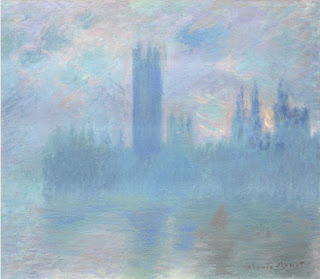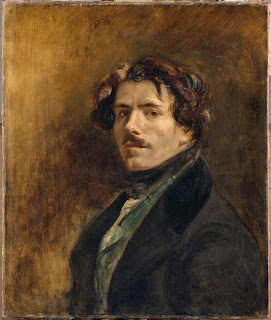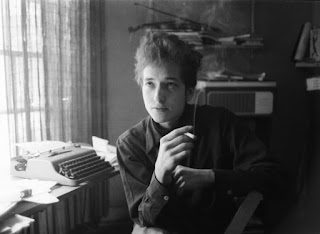IMPRESSIONISTS IN LONDON
IMPRESSIONISTS IN LONDON
French Painters in Exile
Do not be surprised, as I was, Impressionists in London. "The title is misleading - it would be more accurate to use its subtitle," French Artists in Exile, 1870-1904, "but certainly Impressionists sell more tickets. No matter, it is still an extremely interesting exhibition that is worth seeing.
The show starts out as a sort of illustrated history lesson, setting the stage for many people in London to escape the horrors of the four-month Siege of Paris during the Franco-Prussian War (July 1870-January) 1871), during which starring Parisians were forced to eat pets, rats, and zoo animals, and the uprising that followed the city of Paris set up a left-wing government known as the Commune, which was soon viciously crushed by the national government (not the first time in Paris) in a bloody massacre or some 20,000 of the Parisian upstarts. Many of the city's monuments, including the Tuileries Palace and the Hôtel de Ville, were destroyed by the rebellious Communards.
These events forced Emperor Napoleon III and his wife Eugénie to flee to London, and they had become just about impossible in Paris. One of them, James (not Jacques-Joseph) Tissot, figures large in the exhibition, since he stayed in Paris during the war, fighting to defend the city from the Prussians, and later joined the Communards, all the while sketching the scenes or horror he witnessed, including the execution of Communals by the government at the Bois du Boulogne on May 29, 1871. His watercolor "The Wounded Soldier" (c.1707) is particularly affecting, showing the handsome young man slumped against a wall (probably in the Comédie Française, which was used as a hospital during the siege).
Among other artists, Gustave Doré was represented in the events of the terrible year, including a grim winter's night scene, in which a burned child while Paris burns in the background.
One oddity in this section is Jean-Baptiste Corot's premonitory painting "The Dream: Paris Burning" (1870), painted before the Prussians arrived in Paris, depicting a nightmare he'd had the night before of Paris in flames, a statue of Marianne , the national symbol, still standing in the center as the exterminating angel flies overhead.
Tissot pops up in the London section of the show in much happier circumstances: he thrived in London, where he got his first name, and became a popular society artist, painting colorful scenes that mocked English social customs, including the wonderful "Too Early "(1873), which depicts the consternation caused by the early arrival of a ball of lavishly dressed guests.
The artist Alphonse Legros, who helped many of his compatriots find their way in London, plays an important role in the show, as does the sculptor Jules Dalou, represented by his lifelike terracotta statues.
Other anomalies in the show include three of James Abbott McNeill Whistler's "nocturnes," mysterious and beautiful night views of the Thames, and André Derain's Fauvist response to Monet's Parliament paintings.
The curators may have tasks with their themes, but this is still a fascinating and educational show. I recommend it.
Kind regards, Pierre
French Painters in Exile
Do not be surprised, as I was, Impressionists in London. "The title is misleading - it would be more accurate to use its subtitle," French Artists in Exile, 1870-1904, "but certainly Impressionists sell more tickets. No matter, it is still an extremely interesting exhibition that is worth seeing.
The show starts out as a sort of illustrated history lesson, setting the stage for many people in London to escape the horrors of the four-month Siege of Paris during the Franco-Prussian War (July 1870-January) 1871), during which starring Parisians were forced to eat pets, rats, and zoo animals, and the uprising that followed the city of Paris set up a left-wing government known as the Commune, which was soon viciously crushed by the national government (not the first time in Paris) in a bloody massacre or some 20,000 of the Parisian upstarts. Many of the city's monuments, including the Tuileries Palace and the Hôtel de Ville, were destroyed by the rebellious Communards.
These events forced Emperor Napoleon III and his wife Eugénie to flee to London, and they had become just about impossible in Paris. One of them, James (not Jacques-Joseph) Tissot, figures large in the exhibition, since he stayed in Paris during the war, fighting to defend the city from the Prussians, and later joined the Communards, all the while sketching the scenes or horror he witnessed, including the execution of Communals by the government at the Bois du Boulogne on May 29, 1871. His watercolor "The Wounded Soldier" (c.1707) is particularly affecting, showing the handsome young man slumped against a wall (probably in the Comédie Française, which was used as a hospital during the siege).
Among other artists, Gustave Doré was represented in the events of the terrible year, including a grim winter's night scene, in which a burned child while Paris burns in the background.
One oddity in this section is Jean-Baptiste Corot's premonitory painting "The Dream: Paris Burning" (1870), painted before the Prussians arrived in Paris, depicting a nightmare he'd had the night before of Paris in flames, a statue of Marianne , the national symbol, still standing in the center as the exterminating angel flies overhead.
Tissot pops up in the London section of the show in much happier circumstances: he thrived in London, where he got his first name, and became a popular society artist, painting colorful scenes that mocked English social customs, including the wonderful "Too Early "(1873), which depicts the consternation caused by the early arrival of a ball of lavishly dressed guests.
The artist Alphonse Legros, who helped many of his compatriots find their way in London, plays an important role in the show, as does the sculptor Jules Dalou, represented by his lifelike terracotta statues.
Other anomalies in the show include three of James Abbott McNeill Whistler's "nocturnes," mysterious and beautiful night views of the Thames, and André Derain's Fauvist response to Monet's Parliament paintings.
The curators may have tasks with their themes, but this is still a fascinating and educational show. I recommend it.
Kind regards, Pierre







Comments
Post a Comment
Thank you for your response
Kind regards Pierre